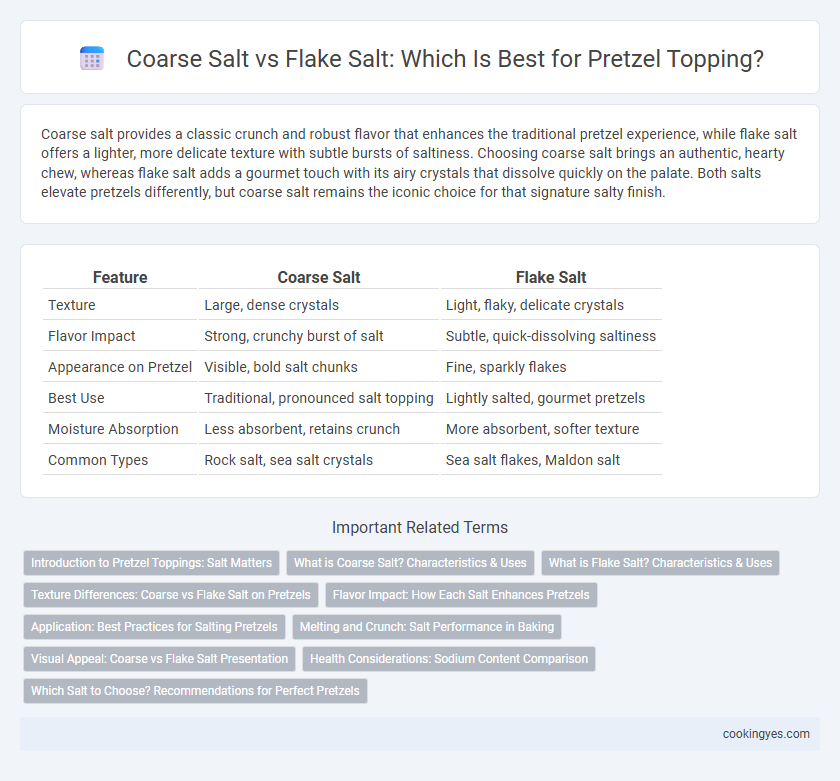Coarse salt provides a classic crunch and robust flavor that enhances the traditional pretzel experience, while flake salt offers a lighter, more delicate texture with subtle bursts of saltiness. Choosing coarse salt brings an authentic, hearty chew, whereas flake salt adds a gourmet touch with its airy crystals that dissolve quickly on the palate. Both salts elevate pretzels differently, but coarse salt remains the iconic choice for that signature salty finish.
Table of Comparison
| Feature | Coarse Salt | Flake Salt |
|---|---|---|
| Texture | Large, dense crystals | Light, flaky, delicate crystals |
| Flavor Impact | Strong, crunchy burst of salt | Subtle, quick-dissolving saltiness |
| Appearance on Pretzel | Visible, bold salt chunks | Fine, sparkly flakes |
| Best Use | Traditional, pronounced salt topping | Lightly salted, gourmet pretzels |
| Moisture Absorption | Less absorbent, retains crunch | More absorbent, softer texture |
| Common Types | Rock salt, sea salt crystals | Sea salt flakes, Maldon salt |
Introduction to Pretzel Toppings: Salt Matters
Choosing the right salt for pretzel toppings is essential for authentic flavor and texture, with coarse salt and flake salt being the most popular options. Coarse salt crystals provide a traditional crunchy bite and strong saltiness, while flake salt offers a lighter, more delicate crunch and a subtler salt distribution. The contrasting grain sizes and dissolution rates directly influence the pretzel's sensory experience and overall appeal.
What is Coarse Salt? Characteristics & Uses
Coarse salt consists of large, evenly sized crystals that retain moisture well, making it ideal for pretzel toppings as it provides a satisfying crunch and visual appeal. Its slow-dissolving nature enhances the savory flavor without overwhelming the dough, preserving the traditional taste and texture of soft pretzels. Commonly harvested through evaporation or mining, coarse salt is preferred in baking for its durability and ability to maintain distinctive salt bursts in every bite.
What is Flake Salt? Characteristics & Uses
Flake salt consists of thin, flat, and irregularly shaped crystals that dissolve quickly and provide a delicate crunch ideal for pretzel toppings. Its light texture and mild saltiness enhance flavor without overpowering the pretzel's buttery dough. Commonly harvested through evaporation processes, flake salt adds a visually appealing, artisanal touch while delivering a clean, fresh taste preferred by gourmet bakers.
Texture Differences: Coarse vs Flake Salt on Pretzels
Coarse salt on pretzels provides a robust, crunchy texture with larger, angular crystals that maintain their shape during baking, offering bursts of salty flavor. Flake salt features thin, delicate layers that dissolve quickly, creating a lighter, crisp surface and a subtler salty finish. The choice between coarse and flake salt directly influences the tactile eating experience and salt distribution on pretzels.
Flavor Impact: How Each Salt Enhances Pretzels
Coarse salt offers a robust, crunchy texture and a burst of intense salinity that complements the rich, doughy flavor of pretzels, creating a satisfying contrast in every bite. Flake salt provides a delicate, flaky structure with a subtle crunch and a cleaner, less aggressive saltiness that enhances the pretzel's slightly sweet and malty notes without overpowering them. Choosing between coarse and flake salt depends on whether a bolder, more pronounced salt flavor or a refined, nuanced seasoning is desired to elevate the overall pretzel experience.
Application: Best Practices for Salting Pretzels
Coarse salt is the traditional choice for pretzel toppings, providing a crunchy texture and bold flavor that adheres well during baking, enhancing the authentic pretzel experience. Flake salt, with its light, flaky crystals, dissolves more easily and offers a subtle saltiness and delicate crunch, ideal for a milder finish and visual appeal. For optimal results, sprinkle coarse salt before baking to ensure even adherence, while flake salt works best applied immediately after baking to maintain its distinct texture.
Melting and Crunch: Salt Performance in Baking
Coarse salt and flake salt differ significantly in melting behavior and crunch, affecting pretzel topping quality. Coarse salt melts more slowly during baking, offering a stronger, lasting crunch and a robust salty burst. Flake salt melts faster, providing a lighter, delicate crunch with subtle flavor integration that enhances the overall texture.
Visual Appeal: Coarse vs Flake Salt Presentation
Coarse salt creates a traditional, rugged look on pretzels with its larger, irregular crystals that contrast sharply against the golden-brown surface. Flake salt offers a delicate, flaky texture and a brighter white appearance, enhancing pretzel visual appeal with an artisanal, gourmet finish. Choosing between coarse and flake salt influences not only the flavor intensity but also the pretzel's overall presentation and consumer perception.
Health Considerations: Sodium Content Comparison
Coarse salt and flake salt used as pretzel toppings differ in sodium content and absorption rates, impacting health considerations. Flake salt typically has a lower density and dissolves more quickly, which can reduce sodium intake per serving compared to the denser, more compact coarse salt crystals. Choosing flake salt for pretzels can help manage sodium consumption without compromising the traditional salty flavor.
Which Salt to Choose? Recommendations for Perfect Pretzels
Coarse salt is the traditional choice for pretzel topping due to its large, crunchy crystals that provide a satisfying texture and robust salty flavor. Flake salt, with its light, flaky structure, dissolves more quickly and adds a delicate burst of saltiness without overpowering the pretzel's flavor profile. For classic authentic pretzels, coarse salt is recommended, while flake salt suits those seeking a subtler finish and a gourmet twist.
Coarse salt vs Flake salt for pretzel topping Infographic

 cookingyes.com
cookingyes.com